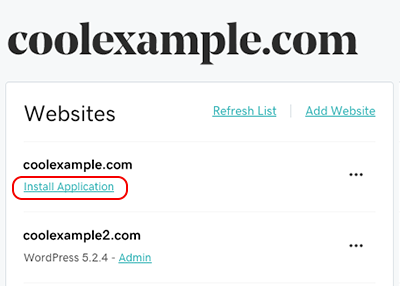Installera WordPress på min Web Hosting (cPanel)-domän med cPanel
Om du vill använda WordPress för att skapa din webbplats och blogg måste du först installera det på ditt värdkonto.
- Gå till din produktsida för GoDaddy- .
- Under Värdtjänster intill det Web Hosting (cPanel)-konto du vill använda väljer du Hantera.

- Gå till kontots Kontrollpanel, avsnittet Webbplatser och välj Installera program under den domän som du vill installera WordPress för. Vi tar dig till Installatrons programväljarsida.

- Välj WordPress-blogg under Appar för innehållshantering.
- Välj + installera detta program.
- Fyll i följande fält, och välj sedan Installera:
Fält Vad ska man göra... Plats - domän Välj det domännamn du vill använda. Obs! För att använda en underdomän (till exempel underdomän.kulexempel.com) lägger du först till underdomänen till ditt konto och uppdaterar sedan programväljarsidan.Plats - katalog (valfritt) Ange den katalog där du vill installera WordPress. För att använda WordPress med domänen du valde i fältet Domän kontrollerar du att detta fält är tomt. Obs! Om du skriver ett ord i fältet kommer adressen (URL:en) för den skapade webbplatsen att ha med detta ord i katalognamnet. Om du exempelvis skriverbloggi detta fält blir webbadressen för din WordPress-webbplatskulexempel.com/blogg.Version Vi rekommenderar att du använder alla standardinställningarna. Inställningar Det finns ett antal alternativ som genereras automatiskt åt dig. Vi föreslår att du anger ditt eget administratörsanvändarnamn och administratörslösenord så att de är lätta att komma ihåg, och att du ändrar administratörs-e-postadressen till ett konto som du använder regelbundet. Varning! Du behöver ha användarnamnet och lösenordet för att kunna logga in på din WordPress-webbplats.Ändra webbplatsens rubrik till namnet på din webbplats och ändra webbplatsens motto till ett kort meddelande som beskriver din webbplats och vad som är syftet med den. Eftersom sökmotorer använder sig av denna information är det viktigt att använda ord som återspeglar ditt varumärke och din verksamhet.
Lämna alternativen för Tvåstegsverifiering, Begränsade inloggningsförsök och Aktivera flera webbplatser på sina standardvärden tills vidare.
Avancerat Välj hur du vill hantera avancerade alternativ såsom databashantering och säkerhetskopior. Vi rekommenderar Hantera avancerade inställningar åt mig automatiskt, men du kan ändra detta när som helst.